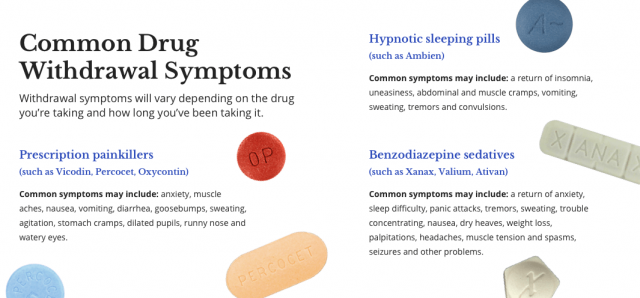Safe Prescription Drug Use
In this era of modern medicine, there’s a pharmacological fix for many ailments, but sometimes, the remedies can cause their own set of problems. Certain medications including, prescription painkillers, anti-anxiety medications and sleeping medications can lead to physical dependence, addiction and other issues. Understanding the risks of these medications and having frank discussions with your doctor can help head off complications.

Powerful prescription drugs are the go-to remedy for a host of ailments.
Someone struggling with anxiety is handed a prescription for a benzodiazepine, such as Xanax (alprazolam) or Ativan (lorazepam). The patient who’s having trouble sleeping receives a prescription for Ambien (zolpidem). A person suffering from chronic pain is given a prescription opioid, such as Percocet (oxycodone/acetaminophen) or Vicodin (hydrocodone/acetaminophen).
At first, the drugs may seem to work like magic — and they work quickly. The Xanax takes the edge off. The Ambien provides a restful night’s sleep. The Percocet eliminates the pain.
But over time, the dark side of these drugs can emerge. One day, the patient needs more than the usual dose of medication to get relief. Or the patient tries to stop taking the pills and feels horrible. The patient is suffering from withdrawal because his or her body has become dependent on the medication. Physical dependence can occur with the chronic use of many drugs, even if medication is taken exactly as directed. Dependence is not the same as addiction, although addiction may accompany or follow dependence.
For many patients, this is how the cycle of dependence and addiction starts, and the toll is tremendous. In 2017, approximately 18 million Americans older than the age of 12 misused a prescription drug. Nearly 218,000 Americans died between 1999 and 2017 from overdoses related to prescription opioids, according to the Centers for Disease Control and Prevention (CDC).
There is a lot of information to know about taking these medications, and physicians sometimes fail to mention all of these risks when they prescribe the medications to patients. Additionally they may provide little or no information about when or how to stop taking the drugs.
That’s why it’s essential to get important information and ask questions before you start taking these types of drugs. When you understand the risks, you can take steps to avoid them.

Talking to Your Doctor
Before taking any medication, it’s crucial to talk to your health care provider about the benefits and risks of the drug. This is especially the case with prescription painkillers and other central nervous system depressants, which have a host of serious side effects and can cause dependence when you take them for a long time.
Asking your doctor why they’ve selected a particular medication and how the drug works is a good starting point for this critical conversation.
It’s important to understand your diagnosis and the sort of results the medication will deliver. If your doctor has prescribed opioids for back pain, for instance, find out what he or she thinks is causing your pain. Will the medication improve your condition or just treat the symptoms? Or is there another way to get to the root of the problem and fix it?
Additionally, it is important to set goals for treatment, so that medications can be stopped or changed if the goal is not reached. For instance, if a benzodiazepine such as Ativan is prescribed for anxiety and it does not work for the patient in relieving symptoms, the medication should be discontinued and a different medication should be selected.
- What are the benefits and risks of taking this medication?
- What are my treatment options?
- Are there better, safer (or non-addictive) alternatives?
- What are the medication’s side effects?
- How will this interact with my other medications?
- Can I safely drive while taking this medication?
- How long should I take this drug?
- How should I stop taking this drug? (Can I stop it suddenly or will I need to be weaned off of it?)
If you find this sort of conversation nerve-racking or uncomfortable, know that you’re not alone. Many people find doctors intimidating or worry that their doctors will think they are questioning their judgment. With the typical medical appointment lasting about 15 minutes, other patients simply feel too rushed to bring up their concerns.
A good doctor, however, will make time for these conversations and encourage you to be an active participant in your health care decisions. If you’re too shy or tongue-tied, take a friend or relative with you who can advocate for you. It can also be helpful to bring a list of questions with you to the appointment.

Understanding the Risks
Not everyone who fills a prescription for an opioid will become addicted. A 2017 report by the National Academies of Sciences, Engineering and Medicine suggests that approximately 8 percent of those given prescription painkillers will end up with a diagnosed “opioid use disorder” and up to a quarter will engage in behaviors that suggest a substance abuse or misuse problem.
Physical dependence on opioids can occur in as little as four to eight weeks. And dependence on benzodiazepines and hypnotic sleep medications like Ambien can occur within three to four weeks of regular use, according to studies.
That’s why many physicians will prescribe the lowest dose needed for as short a time as possible.
But Dr. Chris Johnson, an emergency room physician who has worked on the front lines of the opioid epidemic, told Drugwatch that “there is no ‘risk-free’ dose of opioids,” and the risk of dependence and addiction escalates the longer you take them.
Dependence and Withdrawal
Tolerance and dependence are physiological changes that occur when you repeatedly use a drug. Tolerance is usually characterized by needing to take higher levels of a drug to get the same effect. Drug dependence often follows.
When you’re dependent on a drug, your body needs it in order to function normally, and you may feel sick and suffer withdrawal symptoms if you don’t take it. Dependence develops because the drug causes changes to your brain’s neurochemistry. It is a normal and expected response when certain medications, such as benzodiazepines and opioid painkillers, are taken for a prolonged period of time. Dependence and addiction are not the same thing, and patients with dependence should not suddenly stop taking their medication since it will cause withdrawal.
Withdrawal may be hard to identify at first, and the signs of trouble may seem counterintuitive.
With opioids, for instance, withdrawal may first manifest as an increase in pain, and a patient with chronic pain may interpret this as a “flare up” of their condition, according to Johnson.
But if your pain level has increased, that’s often the first warning sign that you’re tolerant to the medication. Withdrawal symptoms may follow, and patients shouldn’t wait for severe symptoms to manifest to suspect they are experiencing withdrawal from a drug.

You should talk to your doctor as soon as you suspect you’re showing signs of tolerance or experiencing withdrawal symptoms. He or she may be able to create a tapering schedule for you to gradually reduce your dose and minimize withdrawal.
- Prescription painkillers (such as Vicodin, Percocet, Oxycontin)
- While opioid withdrawal feels miserable, it’s not usually life-threatening. Common withdrawal symptoms may include: anxiety, muscles aches, nausea, vomiting, diarrhea, goosebumps, sweating, agitation, stomach cramps, dilated pupils, runny nose and watery eyes.
- Benzodiazepine sedatives (such as Xanax, Valium, Ativan)
- Common symptoms of benzodiazepine withdrawal may include: a return of anxiety, sleep difficulty, panic attacks, tremors, sweating, trouble concentrating, nausea, dry heaves, weight loss, palpitations, headaches, muscle tension and spasms, seizures and other problems. Some people develop a protracted withdrawal syndrome that can drag on for months or years.
- Hypnotic sleeping pills (such as Ambien)
- Patients suffering Ambien withdrawal may experience a return of insomnia, uneasiness, abdominal and muscle cramps, vomiting, sweating, tremors and convulsions.
Physical dependence can occur with the chronic use of many drugs, even if you take your medication exactly as directed. Dependence is not the same as addiction, although addiction may accompany or follow dependence.
A Closer Look at Benzodiazepine Dependence
Benzodiazepine dependence doesn’t get nearly the attention that opioid dependence does, but the problem is significant.
Benzodiazepine dependence may occur in approximately one half of patients who take sedatives for more than a month. Those who’ve experienced it say it can happen even more quickly.
Dr. Christy Huff, a cardiologist and co-director of the Benzodiazepine Information Coalition, told Drugwatch that her doctor gave her a prescription for a low dose of Xanax (0.25 mg) in 2015 when she was suffering from insomnia and anxiety related to an excruciating bout of dry eye syndrome.
“I was warned about addiction. I don’t have a history of abuse or an addictive personality, so I thought as long as I was following my doctor’s instructions, I was safe,” Huff said in a phone interview. “What I didn’t realize is dependence is different and can develop quickly — in the matter of a week.”
After about three weeks of taking the drug to sleep at night, Huff developed a tremor and worsening anxiety. The symptoms were so unbearable that she soon began taking a second dose of Xanax in the middle of the day for relief.
When she told her doctor what was going on, her doctor put her through a battery of medical tests that turned up nothing.
“Nobody ever said the medication could be causing your problem,” she recalled.
“I don’t have a history of abuse or an addictive personality, so I thought as long as I was following my doctor’s instructions, I was safe. What I didn’t realize is dependence is different and can develop quickly — in the matter of a week.”
In fact, Huff had developed tolerance and a physical dependence on alprazolam and was suffering from what’s known as “interdose withdrawal.” The phenomenon, which causes withdrawal symptoms in between doses, is common with short-acting benzodiazepines such as Xanax.
Like many who end up dependent on benzodiazepines, Huff developed an array of excruciating withdrawal symptoms. Hers included profound fatigue, cognitive problems, brain fog, muscle spasms, muscle weakness, stomach upset, and sensitivity to light and sound.
To ease her agony, her doctor switched her to Valium, a longer-acting benzodiazepine, and began a long, slow taper. In the end, it took her three years and three months to taper off of benzos completely.
Huff works with the Benzodiazepine Information Coalition to educate others about the dangers of benzodiazepine use and provide resources for those who are dependent.
Addiction
Addiction is another risk associated with opioids, benzodiazepines, sleeping pills and other types of mind-altering drugs.
Addiction is different than physical dependence and less common, Johnson said, because it involves not just having withdrawal symptoms, but an inability to stop using the drug despite its adverse effects on your health and life.
A person who is addicted to a drug will usually experience intense cravings and compulsively use the drug. The user may spend a great deal of time thinking about the substance and figuring out ways to obtain it.
With prescription drug addiction, people may attempt to obtain more pills than they need or refill their prescriptions early. They may also try and obtain the same prescription from several practitioners, a phenomenon known as “doctor shopping.”
Once addiction occurs, treatment options are available. However, a 2017 study in the Journal of Addiction Medicine that showed that even when getting treatment at a medical clinic, the fatality rate for people with an opioid use disorder is extremely high compared to the general population.
Overdose
Almost one in five patients who sought medical treatment for addiction died within 10 years. Approximately 20 percent of those deaths were due to overdose. The risk of dying from a drug overdose is especially high right after treatment for addiction. That’s because a person’s tolerance drops quickly after any sort of prolonged period of drug abstinence, and if they return to their prior level of drug use, their body won’t be able to handle it.
Overdose can also occur in patients taking these medications as prescriptions, especially with high doses of opioids. Additionally, accidental ingestion by a patient, family member, or child could lead to overdose.
Knowing the signs of an overdose is crucial.
- Unresponsiveness
- Pinpoint pupils
- Slow, irregular, or no breathing
- Pale face
- Bluish lips or fingers (darker-skinned people may appear gray or ashen)
- Excessive drowsiness or sedation
- Confusion or altered mental status
- Cool or clammy skin
- Low blood pressure
- Sluggish reflexes
- A weak or rapid pulse
- Vomiting
- Anxiety and agitation
- Confusion or altered mental status
- Drowsiness
- Blurred Vision
- Unresponsiveness
- Trouble breathing
- Low blood pressure
- Muscle weakness
- Slurred speech
- Hallucinations
- Drowsiness
- Slowed heartbeat
- Trouble breathing
- Coma
Mixing medications can increase the risk of an overdose. More than a third of fatal opioid overdoses occur when people use opioid painkillers and benzodiazepines together. Both types of drugs suppress breathing, and those effects are greatly multiplied when used in combination. If you are taking both a benzodiazepine and opioid painkillers, talk to your doctor about safe use.
If someone has an addiction to opioids or has a prescription for high doses of opioids, it’s wise to have an antidote on hand. Naloxone, also known as Narcan, can reverse an opioid overdose if it’s given in time. It comes in several forms, including a nasal spray and an injection. Naloxone can be obtained from the pharmacy and kept on hand in case of an emergency. Emergency responders carry naloxone with them, so calling 911 in the event of an overdose could be life-saving.

PTSD and Other Risk Factors
Anyone can become physically dependent on a drug. But some people, including those with post-traumatic stress disorder and mental health disorders, have a higher risk of developing an addiction to opioids and other substances.
As Johnson explained, addiction is linked to distortions in the brain’s reward system. Chemicals, such as opioids and benzodiazepines can effectively hijack this reward system — as can pleasant activities, such as gambling, social media and video games.
But people who’ve had their normal reward systems disturbed through traumatic events face an even higher risk, Johnson said, because the reward pathways are also responsible for us feeling comfortable in our skin from minute to minute. As a result, people with PTSD may turn to substances to ease their discomfort.
“Furthermore, opioids and addiction deaths have been described as part of the phenomenon as ‘deaths of despair,’” Johnson said. “These deaths of despair include suicide and alcohol along with opioids. Anyone from any socioeconomic status can develop addiction, but the rates of addiction still hit those with lower status and more difficult prospects harder than those better off.”
Other risk factors — including genetics, a family history of substance abuse, and a history of mental health problems — can also increase a person’s chance of developing an addiction.
Certain psychological and social stressors can also lower the bar. A person might be more vulnerable to misuse substances after losing a job, moving or going through a divorce, for instance. You should make your doctor aware of any difficult or stressful situations in your life.

Safe Use of Painkillers
In some situations, taking an opioid may be the best treatment option. Opioids are often the only reliable method to control pain related to cancer or other terminal diseases.
Likewise, if you’re undergoing major surgery or have suffered trauma from an accident, an opioid may be the only feasible method of providing adequate pain relief. There are still important precautions you and your healthcare team can take to ensure safe use of the drug.
According to the CDC, doctors should prescribe the lowest effective dose of an opioid and provide no greater quantity than is needed: usually three days’ worth of medicine or less. Only in rare cases, will more than a week’s worth of medication be necessary.
“Patients with an acute injury such as fracture or kidney stone should plan on taking these medicines no more than a few days and plan to stop altogether in no more than a week as a general guideline,” Johnson said.
Opioid Dos and Don’ts:
- Never take a larger dose of the medicine than your doctor has prescribed and never take your pills more frequently than it says to on the pill bottle.
- Don’t combine your painkillers with alcohol, sedatives or other drugs (including over-the-counter medications) that cause drowsiness.
- Never share or sell your pills.
- Store your medication in a secure (locked) cabinet out of the reach of children, relatives and visitors, and keep track of your pills.
- Dispose of any unused pills through a community drug take-back event or by disposing of them in the garbage. You can learn more about proper disposal methods from the FDA.
Post-Surgery Painkillers
If you’re being prescribed opioids for pain after surgery, you should also understand your responsibilities as a patient. According to the CDC, that includes knowing how often to take your medication, how to properly store it and how to dispose of any unused pills.
Patients also need to have realistic expectations about post-surgical pain relief.
“[You] should expect some ongoing pain, which is normal,” Johnson said. “Patients should not expect opioids to be taken to make one pain free until the healing has progressed to the point that when they stop taking opioids they are also pain-free. Opioids after an injury or a surgery should be taken only with the expectation that the worst of the pain will be mitigated for a few days.”
Calling this number connects you with a Drugwatch.com representative. We will direct you to one of our trusted legal partners for a free case review.
Drugwatch.com's trusted legal partners support the organization's mission to keep people safe from dangerous drugs and medical devices. For more information, visit our partners page.

